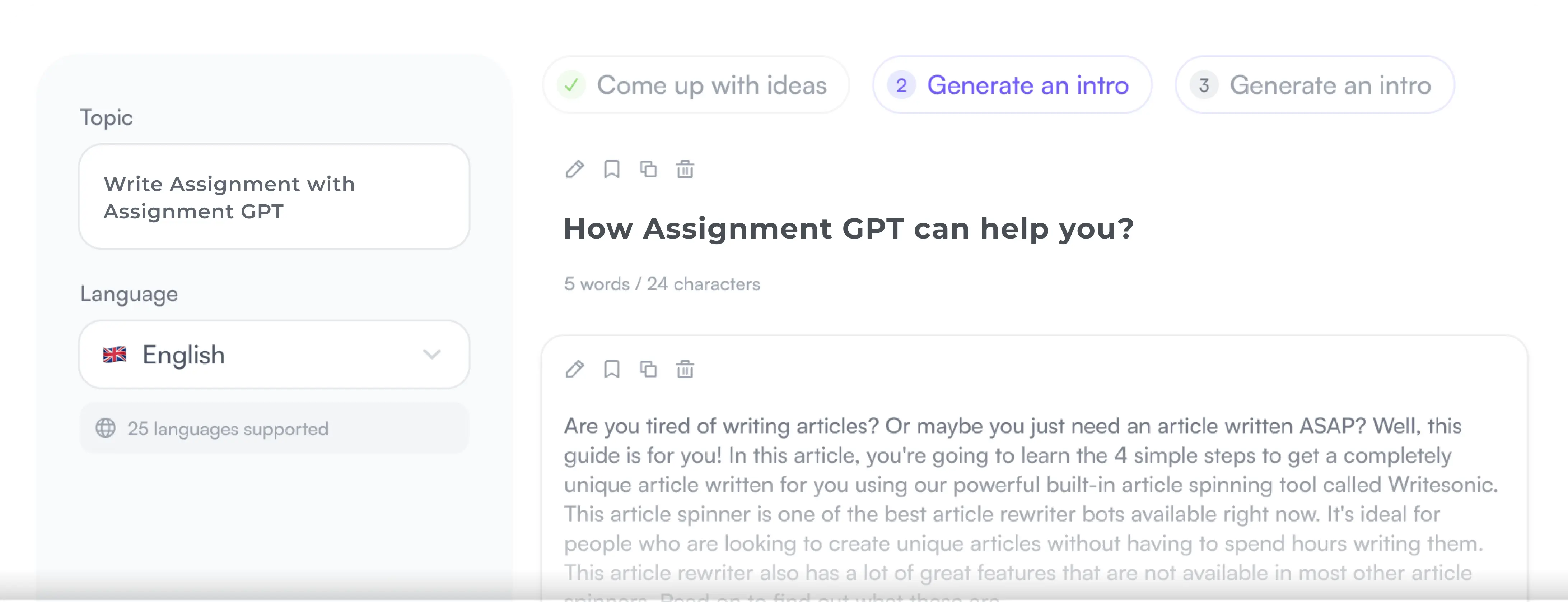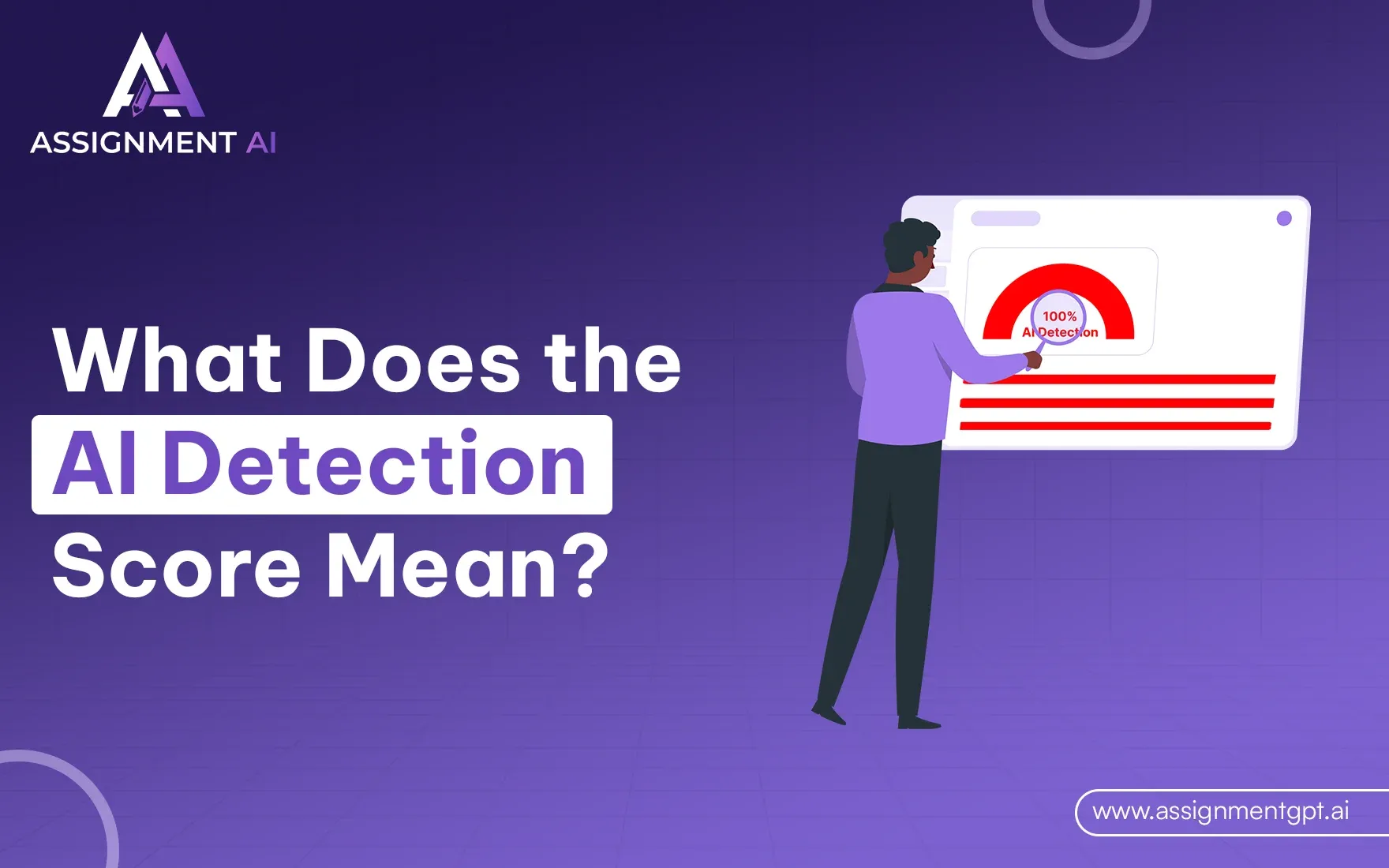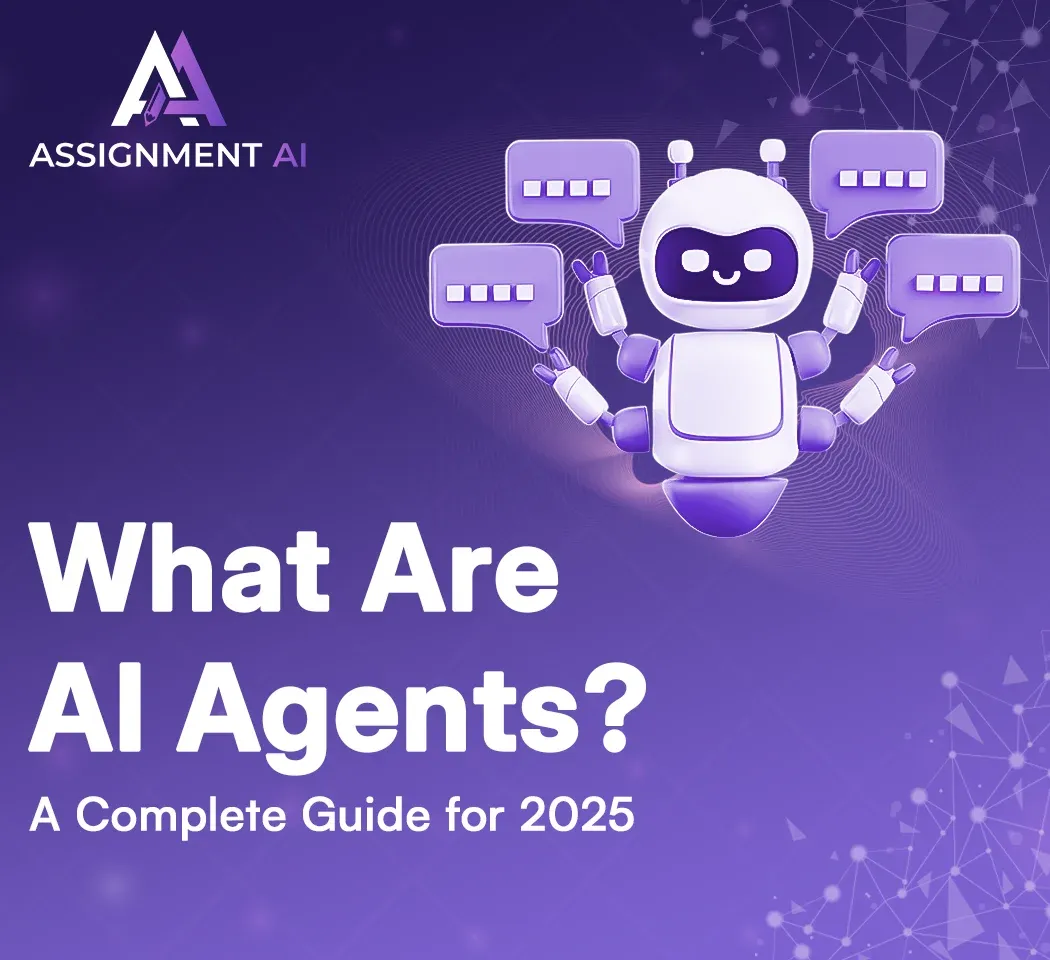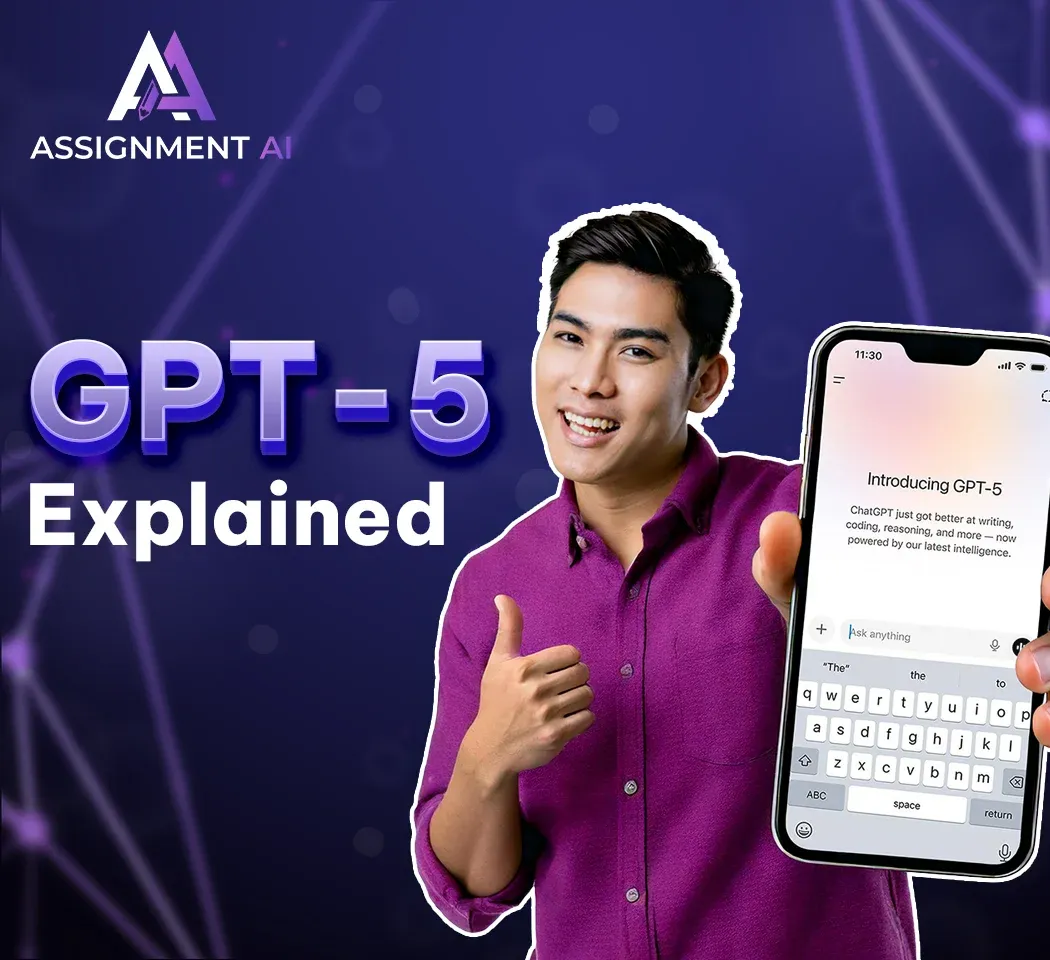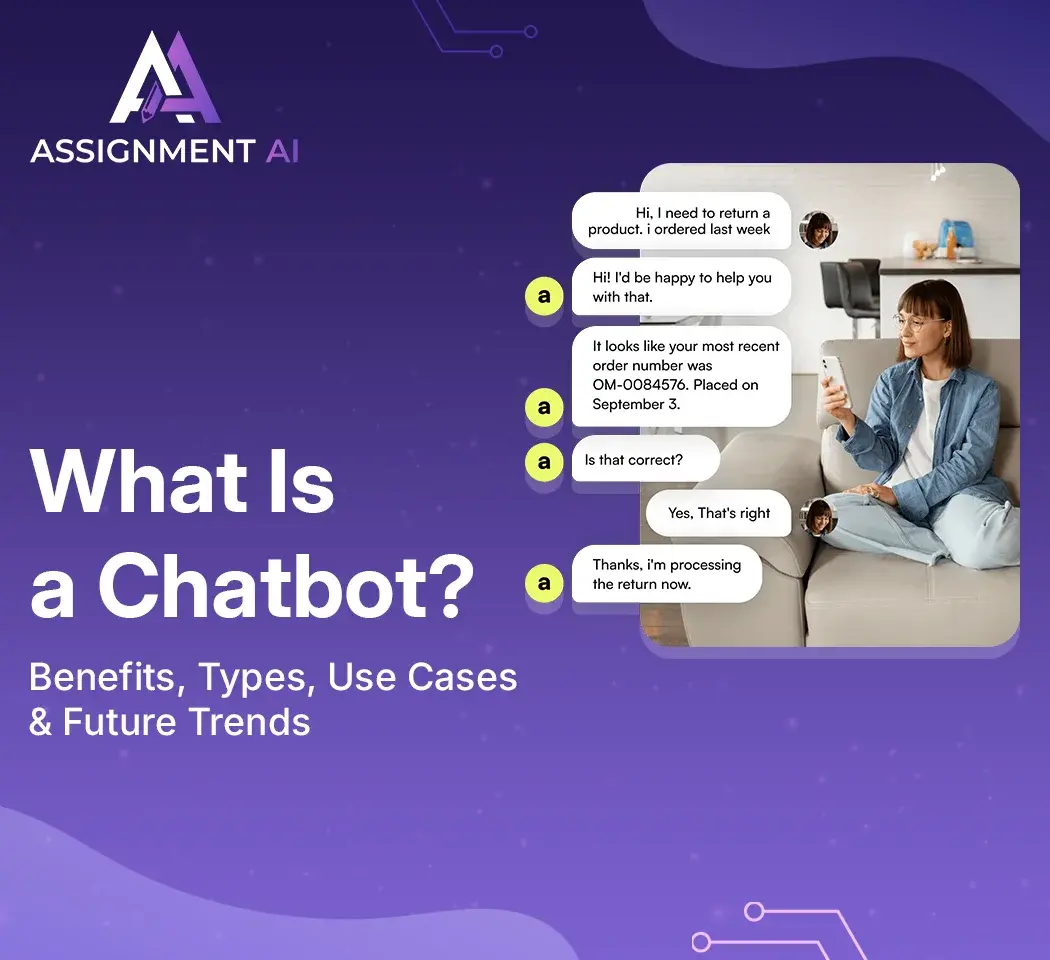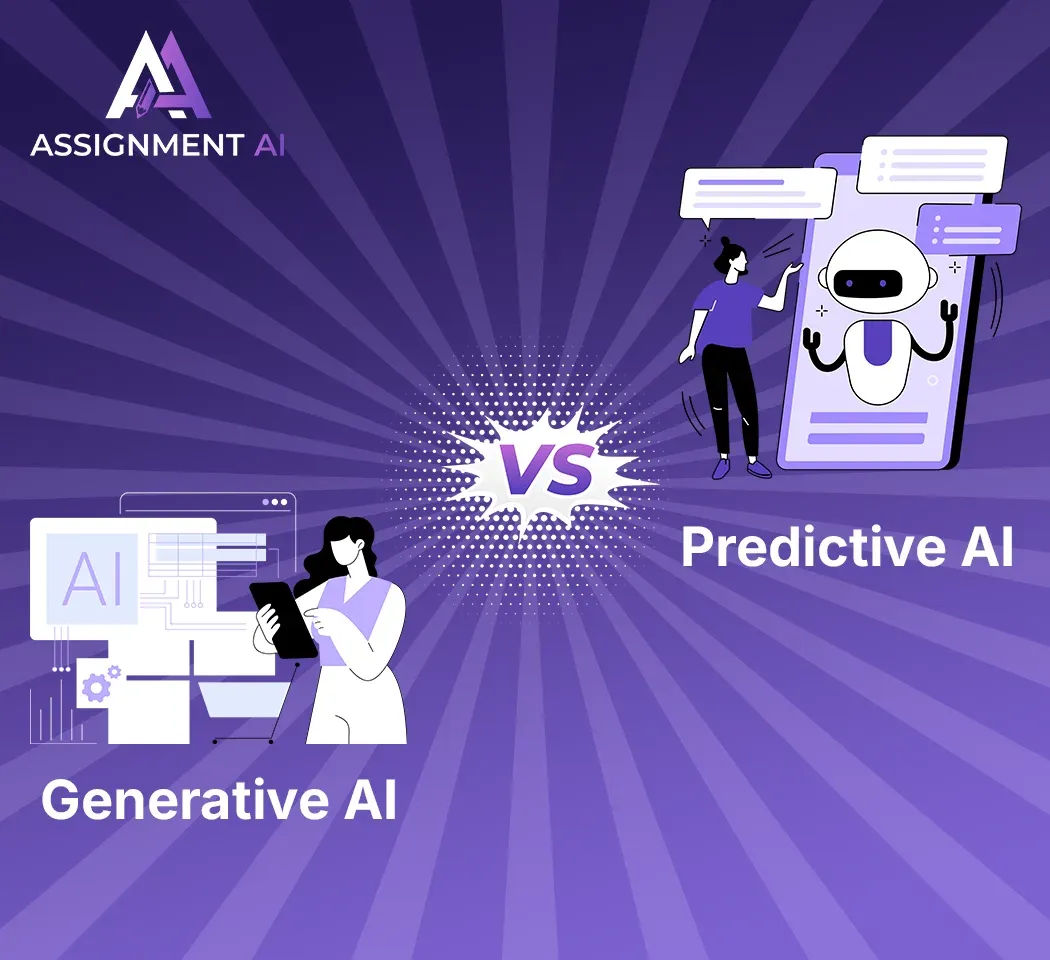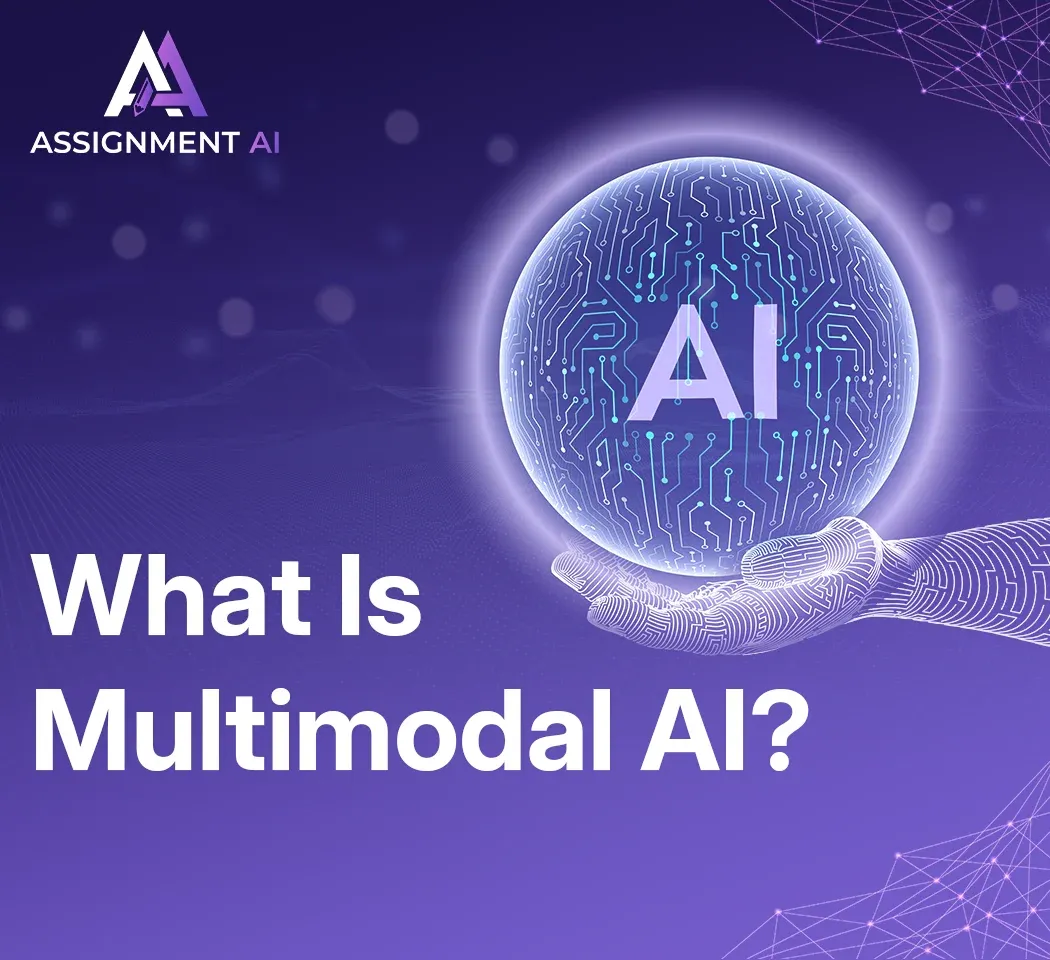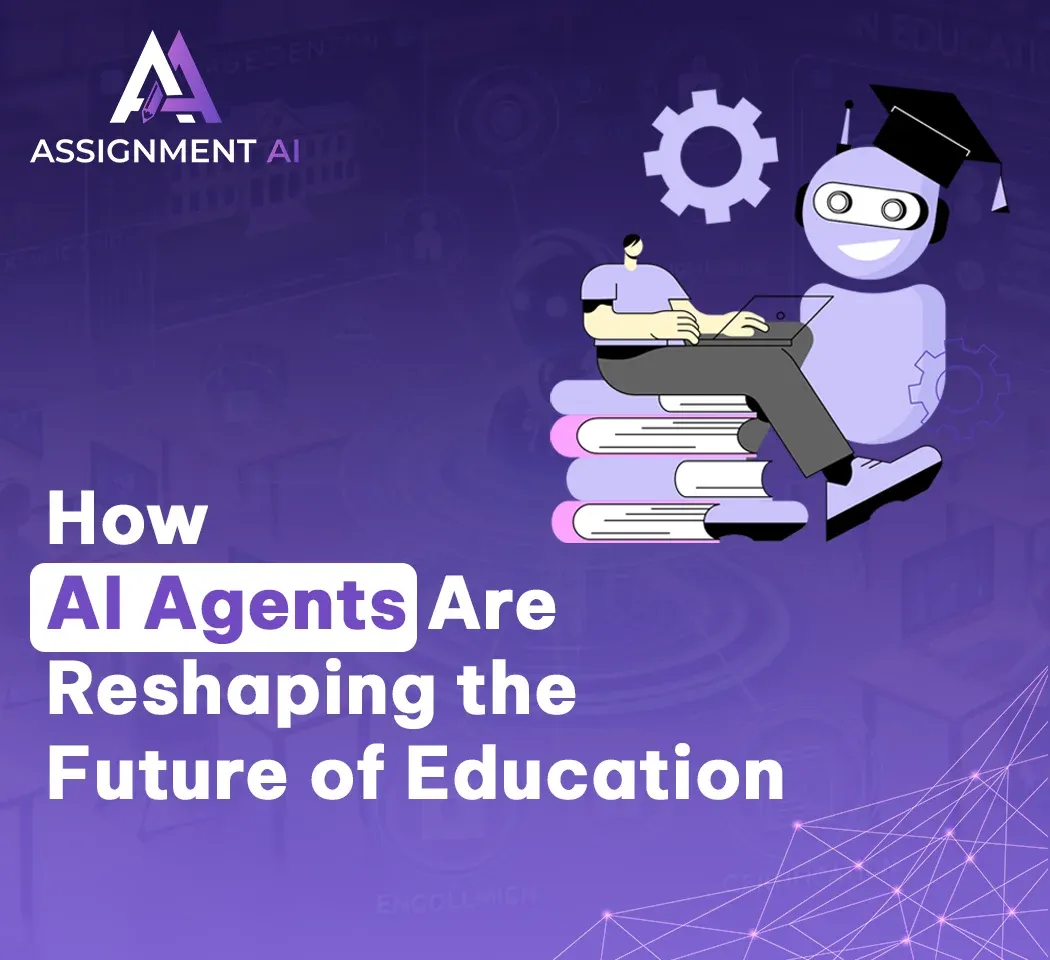AssignmentGPT Blogs
Just imagine that you worked hard the whole day writing a blog post or an essay for your marketing pitch, and you are feeling very proud that your content will pitch your ideas well to the clients. Before the final presentation, you checked your content on AI detection platforms, and after seeing the results, you were surprised that your content got 40% AI detection but you did not use ChatGPT or any other tool. Or in the second scenario, you used a little bit of AI tools to polish your content, and now you are afraid that your content may be flagged as AI-written.
A new survey has released that 74% of the content of new web pages is being generated using AI and to solve this problem most industries and institutions use AI detection platforms in which leading detection tools like AssignmentGPT AI detector, Copyleaks or originality AI detector are used to detect AI content and these platforms give "AI detection Score" in output which means how much portion of your input content can be generated by AI. Today in this detailed article, we will try to understand this AI detection score and how it works.
Quick Summary
Due to the large use of AI-generated content, many AI detection platforms are used in the market to find out whether the content is written by the writer himself or it is generated by some AI tool like ChatGPT, Gemini or Claude.
Mostly the results of AI detection platforms are of this type like for example: 60% AI and 40% original, overall these results mean how much portion is human written and how much is AI generated. Understanding how does AI content detection work helps interpret these scores better. But still many writers are confused as to how the score of these AI detection tools works and what is its exact meaning, we will try to know the answer to this question in this detailed article today.
What is the AI Detection Score?
We have learned about the basics of AI detection score, now let us try to understand the meaning of AI detection score in a little detail through an example. For example; to check AI detection of your 1500 words article, you passed your content into AssignmentGPT AI detector and submitted the content for scan, and in the results you got 20% text that is likely to be written by AI and 80% text is likely to be written by Human.
This score means how much % of your content is generated by AI and how much is written by Humans, in this scenario, 20% of content would have been generated using AI tools like ChatGPT and 80% of content was written by a human writer. And the most important thing is that the scores shown by AI detection platforms are mostly based on probability, as the accuracy of AI detection largely depends on the platform and content complexity. And AI detection results can also be false positive or negative.
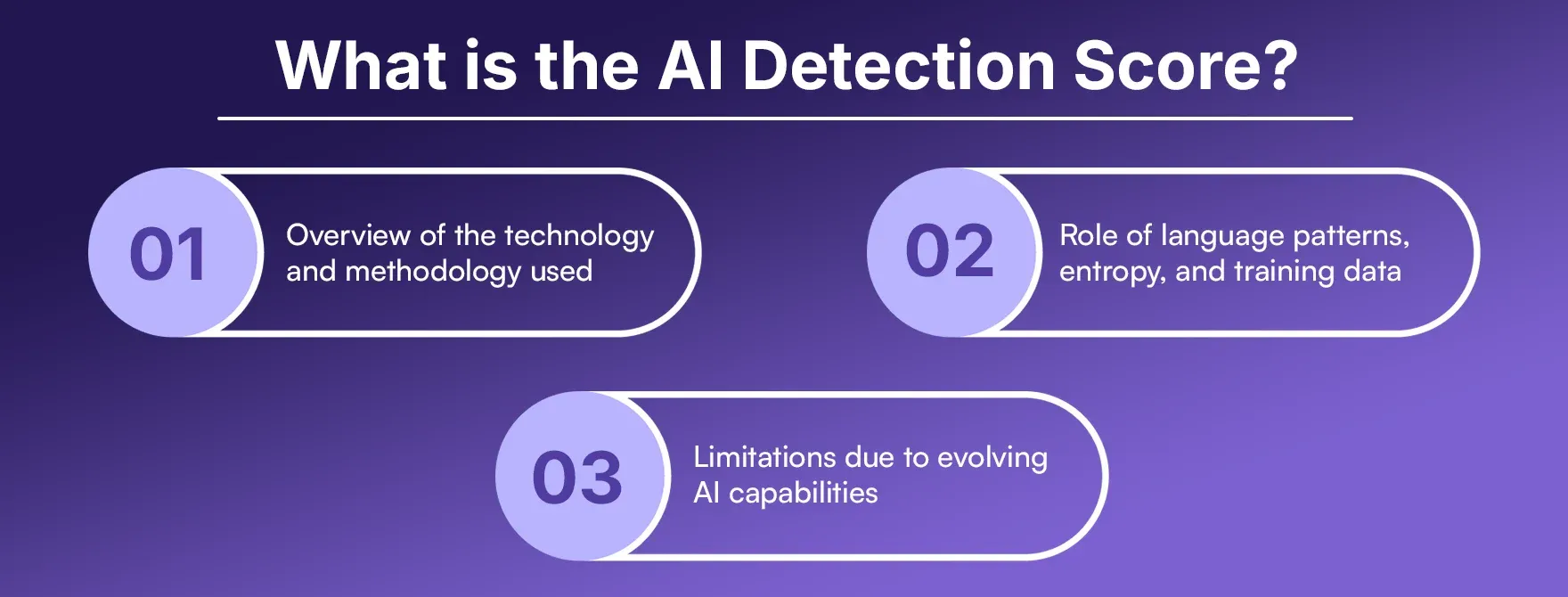
Overview of the Technology and Methodology Used
So let's know how these tools actually work. Many people think that they just guess the AI content after reading the text, but in reality, they analyze your complete content and every phrase in it using advanced pattern trends, so let's try to know in a little more detail about its methods and technology by which AI detection is performed.
Machine Learning Models
All these tools are trained on massive datasets that include millions of human-written content and AI-generated content as a sample, so that they can understand the content creation patterns of different platforms like ChatGPT, Claude or Gemini. This process helps them detect ChatGPT written text accurately. so that they can understand the content creation patterns of different platforms like ChatGPT, Claude or Gemini so that when a user requests it for AI detection, the AI tool analyzes the content using information from its available datasets and tries to differentiate which portion feels like AI written and which is human written.
Language Patterns
AI detection tools try to understand the structure of a sentence, word choice and its writing pattern as AI always creates professional and polished content. This understanding helps in detecting AI writing patterns effectively. Where the length of sentences and the writing style are quite consistent. But human writing is not like this, content written by a human writer has a lot of variation.
Entropy and Predictability
Entropy measures how random or unpredictable a piece of text is, generally AI-generated text often has lower entropy because it’s more predictable, as you might have noticed AI Chatbots give very repetitive or predictable answers, AI written tools also follow this same pattern to a great extent. Human-written content is not always predictable, which is why AI tools can know which content is generated by AI and which is written by a human.
Training Data
Mostly, AI detector tools are trained on a huge range of AI models, including ChatGPT, GPT-4, Gemini, and Claude. This makes it good at spotting patterns across different AI tools, not just one. The more diverse the training data, the better the tool can generalize and catch sneaky AI-generated. Advanced AI tools also have a lot of data on human written content, which increases the accuracy of their AI detection score. This is why choosing the best AI detection tool is crucial for accurate results.
Also reqad this article : How Doеs AI Contеnt Dеtеction Work?
Role of Language Patterns, Entropy, and Training Data
Advanced AI detection tools are trained on language patterns, entropy, and mass data, so that AI detection tools can be made more advanced.
Language Patterns
There are many such AI content generation platforms which make grammatical mistakes intentionally to fool AI detection platforms, All these language patterns are trained by AI detection tools so that the accuracy of AI detection can be maintained.
Entropy and Burstiness
Entropy is a measure of how unpredictable a text is. AI-generated text tends to have low entropy because it follows predictable patterns. Burstiness, on the other hand, looks at how much variation there is in sentence length and structure. There is a lot of variation in human writing, such as short lines, unpredictable word usage or complex writing patterns, which allows detection tools to detect whether the content is generated or written by a human.
Training Data
How advanced an AI detection platform is depends a lot on training data. Training Data in AI detection tools includes massive datasets of both human and AI-generated text, including outputs from popular models like ChatGPT, Claude, and Llama. This means it’s seen a ton of examples of what AI writing looks like, so it can spot those telltale signs even in newer models. The more comprehensive the training data, the better the detector can handle edge cases, like text that’s been heavily edited or mixed with human input.
Limitations Due to Evolving AI Capabilities
As AI models are becoming more advanced, AI content humanizers are also evolving, which leads to many limitations on the accuracy of AI detection.
Evolving AI
As AI writing platforms improve, their accuracy increases significantly, and they can copy human writing to a great extent. And now there are many humanizer tools that can bypass many AI detection platforms.
False Positives and Negatives
Sometimes, human-written text gets flagged as AI (false positive), or AI-generated text slips through as human (false negative). I have faced this problem many times. Actually, many platforms focus on specific words and when those words appear in the content, the platform declares the complete content as AI written.
Context Matters
Detectors don’t always understand context. For example, if you’re a non-native English speaker, your writing might have patterns that resemble AI output (like simpler sentence structures), leading to a false positive. Similarly, heavily edited AI text might trick the detector into thinking it’s human-written.
Short Texts
I noticed in many tests that if you scan short content for AI detection, you get an AI-generated result, so it’s also important to check for AI detection and make sure your content has sufficient length and words.
Is the AI Detection Score Accurate?
There is no exact answer to this, as it largely depends on the accuracy of the platform and the complexity of the content. If you check your content with AI detection with any low tools, then the maximum chance is that you will get false, positive or negative results. That is why it is very important that you check AI detection on popular and reputable platforms so that you get good accuracy.
Is the AI Detection Score Perfect?
The score of any AI detection platform is never perfect, because AI detection platforms depend on probability to a great extent, because if the accuracy of the platform is very good then the accuracy of its AI detection score will also be very good but overall no AI detection platform is so accurate that its AI detection score can be called perfect.
Which Model Should I Use?
Mostly the platform offers three models, Lite, Turbo and Multi language, all designed for different needs. Let’s try to know all three.
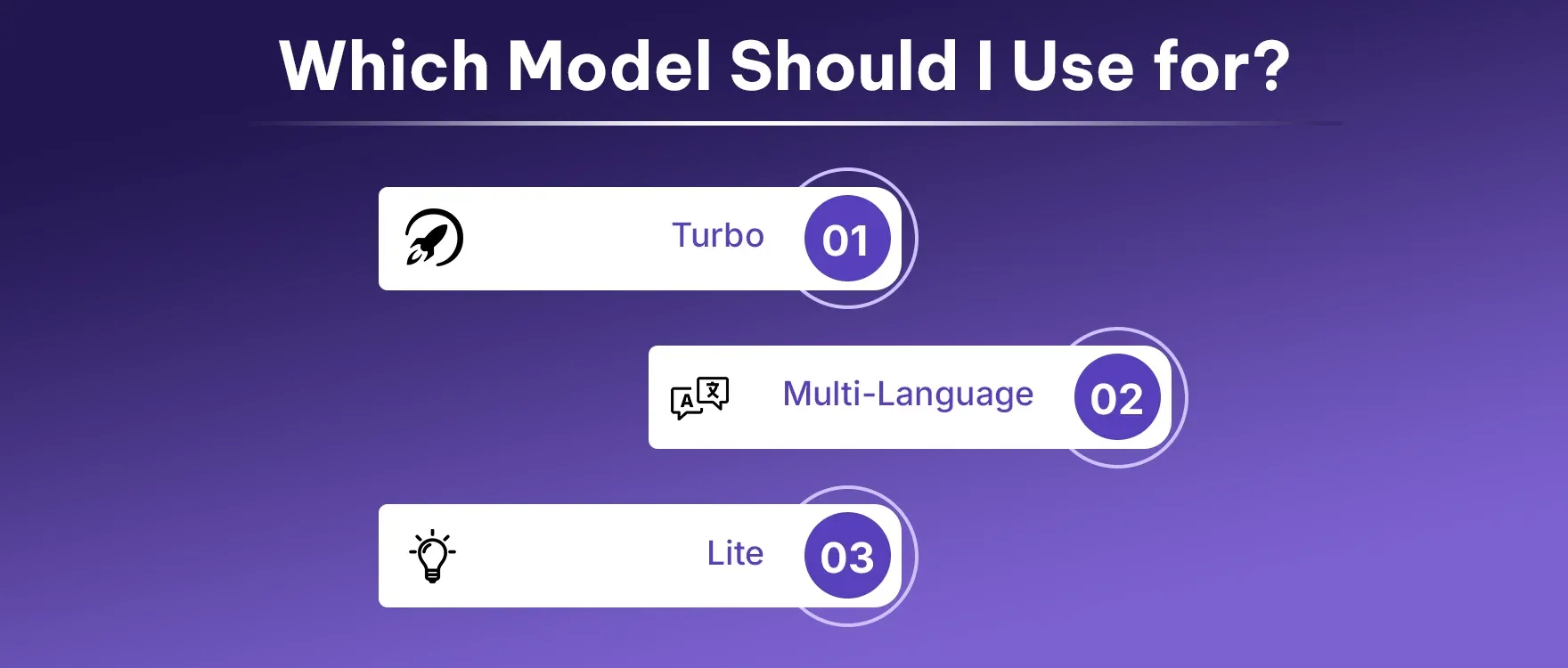
Lite
The accuracy of this model is 98% in detecting AI content and the false positive rate is 1% which makes it more reliable. This model is best for students, educators.
Turbo
The accuracy of the Turbo model is 99%+ in AI detection and its false positive rate is under 3%. This model is best for publishers and marketers. This model is quite strict and if this model finds any specific word unusual then it shows a large portion of the content in the AI written results.
Multi-Language
This model is suitable for people who are working on multi-language contents. Its accuracy is 97.8% in content detection, and its false negative rate is 1.99%. It’s perfect for international publishers, marketers, or educators dealing with content in languages beyond English.
Should Plagiarism Checking and AI Detection Be Treated the Same?
In today's digital world, plagiarism and AI detection are very popular terms in text content creation, but many people feel that both are the same, but in reality, both are very different from each other. Let's try to understand the difference between these two and try to know whether plagiarism checking and AI detection can be treated in the same way.
Plagiarism Checking
Plagiarism checking means trying to match your content with other web pages, books and articles available on the internet and finding similar or exact similar paragraphs, or portions to your content. If the plagiarism detector feels that your content is already available on the internet then such content is considered as plagiarized content.
AI Detection
This is a kind of probability process whether your content can be generated or not. For this, AI detection platforms show the probability that of how much portion of it is generated or how much is human-written.
Plagiarism and AI content are both quite different, the simple meaning of plagiarism is that you have copied someone's content and AI detection means that you are trying to detect such content and find whether any content has been generated by AI or not.
Best Practices for Content Creators
We have learned in detail about how AI detection scores work and what it means, so now let's know that if you are a content creator, blogger, student or marketer, then how can you use AI detection in the right way so that you do not face the issue of AI-generated flags.

Tips for Avoiding Accidental AI Flags
Many times, it happens that your content is written by you, but you still get the result of AI-generated content, so if you want to avoid it, then follow some basic steps.
Mix Up Your Writing Style
It has been seen many times that human authors face issue with AI-generated content only when there are too many predictable patterns, so to solve this problem keep the sentences of your content short, punchy sentences, use personal experiences, references so that there can be differentiation between your content and Ai generated content.
Document Your Process
Use Google Docs to track your writing history, so that your clients and you can see your previous writing history.
Avoid Over-Polishing
Most AI detectors flag content that is too polished. Whenever you use websites like Grammarly, fix basic grammar punctuation and avoid word suggestions or paragraph replacement at all. This can also lead to AI-generated content issues.
Write Longer Content
hort texts (under 80 words) are harder for AI detectors to analyze accurately. So if you are writing a blog, try to write a blog in at least 500+ words so that AI detection has sufficient words to detect the content.
Read More : Top 10 AI Content Detectors of 2025
Using AI Ethically in Content Production
AI is a very important and useful tool in today's copywriting world but it is also very important to use it ethically and responsibly, let's learn about some best practices.
Use AI for Support, Not Replacement
I have seen many new writers who use AI in bulk content generation and most writers feel that AI has already replaced them, but in reality it is not so. Because AI can never do human experience writing, so if you want to use AI then use it only for support and suggestions, not for complete copy paste. Understanding the benefits of using AI content detectors can help maintain this balance.
Disclose AI Use
If you use AI then give (Ai Disclaimer) and clearly state why you used AI tool and in how much portion so that there is clarity between your audience and your clients.
Fact-Check AI Output
Most AI platforms give out-of-context suggestions, ideas, so before accepting any suggestion, cross-check it thoroughly, whether that data is accurate or not.
Maintaining Originality While Benefiting from AI Support
Experts do not say that you should not use AI at all, rather you should use AI tools for the improvement of your content and for better ideas, not for copying and pasting.
Add Your Personal Touch
If AI has given any such data or suggestions which are very beneficial for your content, then you should never copy paste the AI content in such a way, understand its context and try to represent it in your own words in a better way.
Use AI for Optimization, Not Creation
As we have already discussed a lot in the previous paragraphs, that you should use AI tools only for optimizing your content and not for copying and pasting. This means that if you have to do keyword research then there are many AI platforms that can help you in this, if you have to fix content SEO then also there are many platforms for SEO Improvement, the overall conclusion is that you should use AI tools to optimize and improve your content, not for copying and pasting.
Test Your Content
Before submitting or publishing, check your content in advance AI detection tools, for this you can prefer professional tools like AssignmentGPT AI detector. With this, if there is any issue in your content then you will be able to fix it.
Conclusion
It is sure that what is the meaning of AI detection score and how does it work, you must have got this doubt clear, but the main motive of this article is to know the working process of AI detection score as well as how you can avoid it in your content and you should use AI only for ideas and not for content generation, because AI tools can never generate experience content, so you should increase your productivity by using AI and not replace yourself with AI.
Apart from this, always do AI detection of your content on an advanced platform like AssignmentGPT AI detector before final content submission, so that you can send only 100% guaranteed content to your client or institution. This practice aligns with why AI content detection matters for education.
FAQs
1. What does a 60% Original and 40% AI score mean?
2. How accurate is AssignmentGPT AI detector?
3. Can I use AI tools without getting flagged?
4. How can I prove my work is human-written?
5. Is AI detection the same as plagiarism checking?
Content writer at @AssignmentGPT
Ashu Singh, content writer at AssignmentGPT, crafting clear, engaging content that simplifies complex tech topics, with a focus on AI tools and digital platforms for empowered user experiences.
Master AI with
AssignmentGPT!
Get exclusive access to insider AI stories, tips and tricks. Sign up to the newsletter and be in the know!

Transform Your Studies with the Power of AssignmentGPT
Empower your academic pursuits with tools to enhance your learning speed and optimize your productivity, enabling you to excel in your studies with greater ease.
Start Your Free Trial ➤Start your success story with Assignment GPT! 🌟 Let's soar! 🚀
Step into the future of writing with our AI-powered platform. Start your free trial today and revolutionize your productivity, saving over 20 hours weekly.
Try For FREE ➤